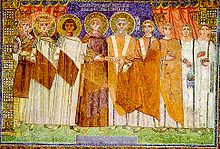Constantine IV (Byzantium)

Constantine IV (* around 650; † 685 ; Latin Flavius Constantinus , Middle Greek Κωνσταντίνος Δʹ ) was Byzantine emperor from 668 to 685 . The nickname Pogonatos ( Πωγωνάτος , "the bearded one"), which is sometimes ascribed to him , should in fact refer to his father Constans II . Constantine IV was the eldest son of Emperor Constantine II; he had two younger brothers Herakleios and Tiberios . He was married to a woman named Anastasia.
During the last years of his life, Konstans had moved his residence to Sicily and insisted in vain that his sons and co-emperors and their mother Fausta Arshakuni should follow him there. When Konstans was murdered in 668, the Armenian Mizizios was proclaimed Augustus (emperor) in Syracuse . According to some sources, Constantine IV is said to have personally sailed from Constantinople to Sicily with a fleet to put down the usurpation ; Whether this is the case is controversial in research. What is certain is that Mizizios came to an end after a few months. The survey of the Saborios failed because he was killed in an accident.
Constantine, who deposed his two brothers in 681 and had them mutilated in order to exclude them from power, was able to record some important successes. So he fended off (following traditional sources) in 678 the first siege of Constantinople by the Arabs, whereby he was able to destroy their fleet. In recent research, however, it is now controversial whether there was a continuous siege of the capital from 674 to 678; possibly it was a blockade or various waves of Arab attacks.
In any case, the Arabs had to sign a 30-year peace treaty with him around 680, which even included Arab tribute payments. Constantine benefited from internal Arab battles in the caliphate and gave his empire an urgently needed recovery phase. Another success was the integration of the Sermesianoi , apparently descendants of the Roman provincial population in Pannonia and the 616 Roman prisoners settled there, who had moved to Macedonia in 680 under the leadership of the Bulgarian prince Kuver , where Kuver had established his own khaganate . A defensive success jointly achieved by Berbers and the exarch of Carthage against the Arabs at Biskra 683 in North Africa brought a little respite here too. Little is known about the emperor's domestic policies. In terms of church politics, an ecumenical council convened by Constantine brought about reconciliation with the Pope (681), which was based on the rejection of monotheletism .
Only the invasion of the proto-Bulgarians in 679 under the brother Kuvers, Khan Asparuch , in the now largely Slavic province of Moesia could not prevent Constantine IV. So that he had to recognize the newly founded Bulgarian empire. In 680 he recognized the Longobard Empire in Italy as independent. Constantine died in 685; he left his son Justinian II, who was raised to co-emperor in 681, as sole ruler.
literature
- John F. Haldon: The Empire That Would Not Die. The Paradox of Eastern Roman Survival, 640-740. Harvard University Press, Cambridge (Massachusetts) 2016.
- John F. Haldon: Byzantium in the Seventh Century . 2nd edition Cambridge 1997, p. 63ff.
- Ralph-Johannes Lilie , Claudia Ludwig, Thomas Pratsch, Ilse Rochow, Beate Zielke: Prosopography of the Middle Byzantine Period . 1st department: (641−867). Volume 2: Georgios (# 2183) - Leon (# 4270). Created after preliminary work by F. Winkelmann . Published by the Berlin-Brandenburg Academy of Sciences. De Gruyter, Berlin 2000, ISBN 3-11-016672-0 , pp. 488-491 No. 3702.
- Alexios G. Savvides, Benjamin Hendrickx (Eds.): Encyclopaedic Prosopographical Lexicon of Byzantine History and Civilization . Vol. 2: Baanes-Eznik of Kolb . Brepols Publishers, Turnhout 2008, ISBN 978-2-503-52377-4 , pp. 239-241.
Web links
- R. Scott Moore: Short biography (English) at De Imperatoribus Romanis (with references).
Remarks
- ^ Marek Jankowiak: The first Arab siege of Constantinople. In: Travaux et Mémoires du Center de Recherche d'Histoire et Civilization de Byzance. Vol. 17. Paris 2013, pp. 237-320.
| predecessor | Office | successor |
|---|---|---|
| Constans II |
Emperor of Byzantium 668–685 |
Justinian II |
| personal data | |
|---|---|
| SURNAME | Constantine IV |
| BRIEF DESCRIPTION | Byzantine emperor (668–685) |
| DATE OF BIRTH | 7th century |
| DATE OF DEATH | 685 |
